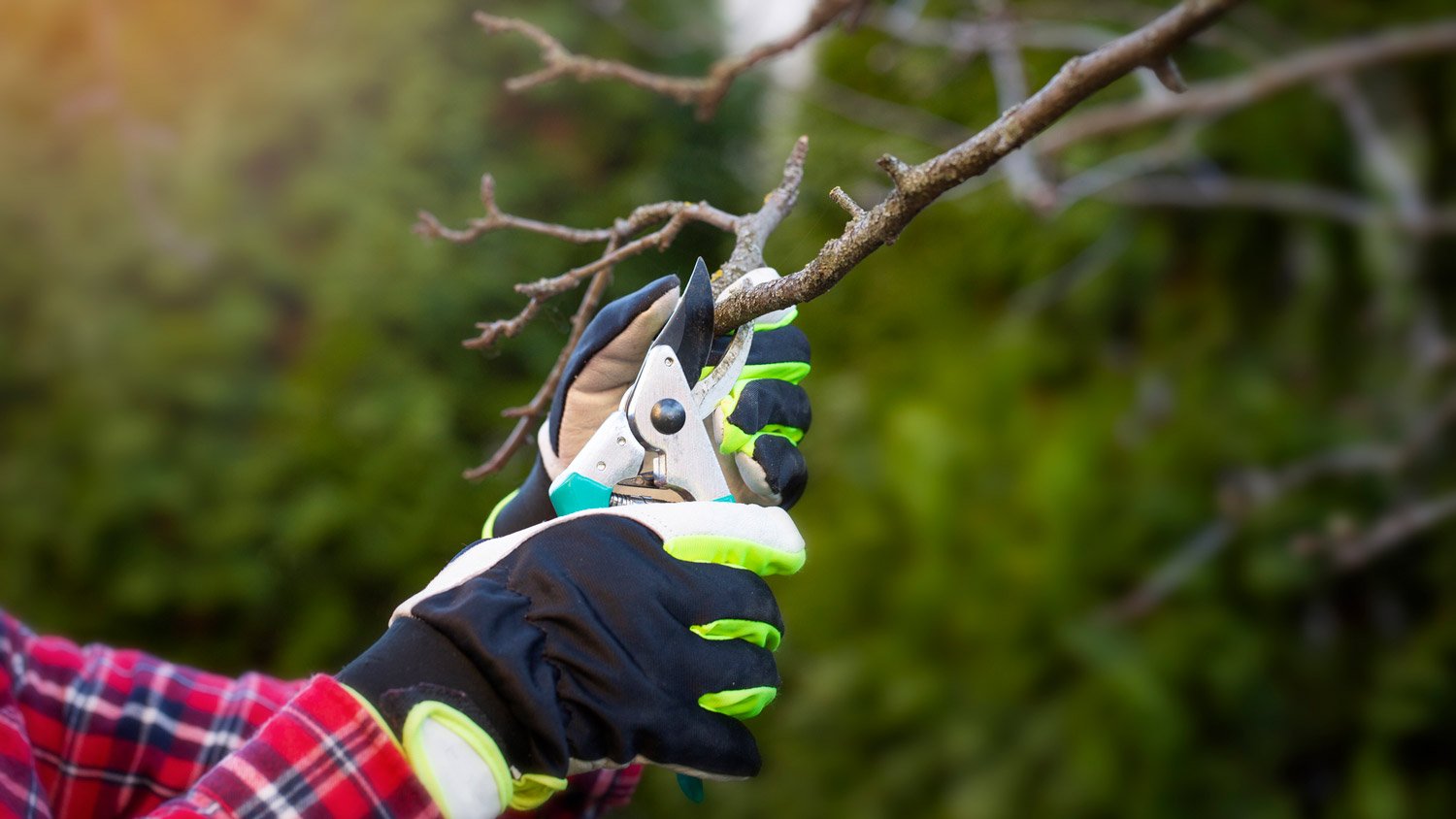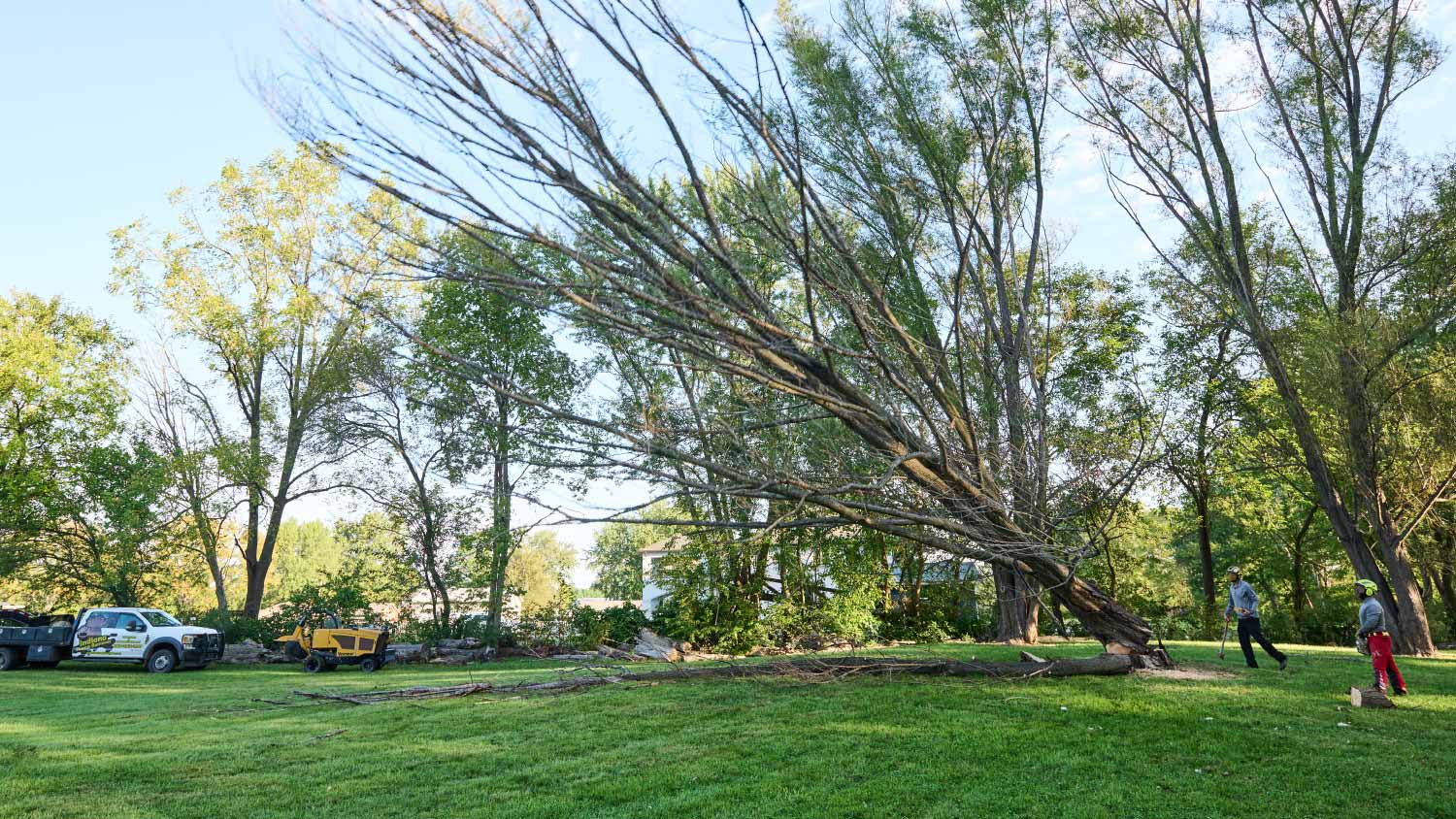
The cost to remove palm trees depends on several factors, including their size, location, and more. Our guide shows the average palm tree removal costs.
Act quickly if lightning strikes a tree in your yard


A tree struck by lightning can explode, split, burn, or suffer severe root damage.
Tree age, species, moisture level, and strike history affect its chances of survival.
Lightning protection systems can shield isolated trees from storm damage.
Call local authorities immediately if a lightning-struck tree causes fire or explosion.
Did you know that thousands of trees get struck by lightning every year? If you have tall trees on your property, you may be wondering how they’ll fare if lightning happens to strike them. Let’s dive into the details of what a lightning strike does to a tree, and how many can survive with the proper care.
A strike of lightning can be immensely powerful. The average lightning bolt is approximately 300 million volts, and can reach a temperature of 50,000 degrees Fahrenheit. Although trees are relatively robust, lightning packs a punch that can be fatal for trees.
A lightning strike can debark, burn, scar, or even split a tree. In many cases, a struck tree dies instantaneously and needs to be professionally removed. Some trees can survive lightning strikes if the lightning damage is not severe. But the tree will be weakened and even mild lightning strikes can expose a tree to disease or pest attacks.
Here’s what could happen to a tree if it’s struck by lightning:
If lightning finds a path through the sapwood or greenwood of the tree, it will instantly ignite the sap and explosively turn the water into steam. Even the most durable tree species can’t survive that sudden expansion, and it may explode violently. Some estimates report that around half of the trees struck by lightning die immediately by explosion.
This result is common when lightning is channeled through the bark, burning a strip of the bark off on its way to the ground and causing some wood damage. Since the inner wood damage is relatively light, trees typically survive, but it creates an opening for bugs and tree fungi to reach vulnerable sapwood inside so the tree will be weaker.
If lightning reaches more vulnerable inner wood, it causes considerably more damage, often splitting the tree in half or causing deep cracks. Survival is difficult but sometimes possible.
Even if lightning causes minimal damage, it can ignite leaves, branches, and nearby sap. The tree catches fire and will likely burn down or suffer significant damage. In a forest, the fire can quickly spread, which is why lightning is a common cause of natural forest fires. If a tree on your property is burning, call your local fire department immediately. Burnt trees may still be holding electrical charge or may have come in contact with power lines, so do evacuate the area quickly.
Sometimes the easiest path lightning finds is tree roots. That’s bad news for the tree: Roots can be heavily damaged and underground fires can start. Trees may struggle to survive with significant root damage, so even minor damage can lead to a slow death if their roots are burned severely.

Keep these points in mind when caring for a tree that’s been struck by lightning:
Find out if the tree is healthy enough to survive. You’ll want to inspect the tree closely to see the extent of the damage, if there’s fire danger, and any exposure of the tree’s inner wood. You’ll also want to look for any damage running down the trunk close to the ground, which could indicate the roots are damaged, too.
If your inspection takes you into uncharted territory, you may want to contact a tree maintenance service near you that can offer a consultation. Professionals can offer valuable services like tree “bracing” to support a damaged tree while it tries to recover.
Remove the tree if the damage is too great. Tree removal costs an average of $750, depending on the tree’s type, health, and size.
Trees can heal from minor damage on their own, although they will be more vulnerable. You can help by ensuring the tree is disease-free and has plenty of water.
If there’s severe bark damage, you can use a knife or shears to carefully remove broken, burnt, or damaged bark.
Remove dead branches before they start decaying. It’s not usually necessary to coat damaged parts of the tree, but spraying with a “contact” fungicide or insecticide may help depending on the species, season, and local threats.
Add a tree-friendly fertilizer to encourage recovery. Again, local professionals can recommend the best kind of fertilizer to use for your soil.
Avoid any extensive pruning of healthy branches for at least one year.
What determines if a tree can survive lightning or what path a lightning strike takes? Some of Mother Nature’s effects are tough to predict, but important factors include:
Age: The more mature a tree, the larger it has grown, making it a more likely victim of lightning and increasing the damage lightning can do as it moves down the tree.
Moisture: In a rainstorm, lightning often takes a path through the water on a tree (water is far more conductive than woody trees), which can greatly reduce the damage to a tree.
Species: The type of tree, the thickness of its bark, how much moisture it holds in its wood, and other factors all affect the damage taken.
Multiple Strikes: Lightning strikes the same place twice all the time, and in a lengthy thunderstorm, it may strike a tall or isolated tree several times.
You can build a lightning protection system to protect a more isolated tree on your property from regional thunderstorms. This process involves attaching lightning rods to the tree to catch the lightning and channel it down cables into the ground. That process depends on the shape of the tree and takes specialized work, so we highly recommend hiring a local tree service pro with experience in protecting trees from lightning.
From average costs to expert advice, get all the answers you need to get your job done.

The cost to remove palm trees depends on several factors, including their size, location, and more. Our guide shows the average palm tree removal costs.

Discover the average tree maintenance cost, key price factors, and tips to save. Get expert insights to plan your tree care budget with confidence.
Get transparent shrub removal cost info. Learn average prices, key cost factors, and tips to save on your next shrub removal project.

Need a tree removed from your yard? Learn how to negotiate tree removal to get the best rates on having dangerous trees removed from your property.

Need to know how to kill a tree? If it’s disrupting your foundation or plumbing, learn how to kill the tree and its roots with these tips.

A credible tree care company should be licensed, carry insurance, have a certified arborist on staff, and be trained in safe tree removal. Here's what to know.